The Old Sweet
Lime Trick
Or
April Fool's Day
can be Any Day
This article first appeared in: Tropical Fruit News April 1992 Vol. 26
No. 4
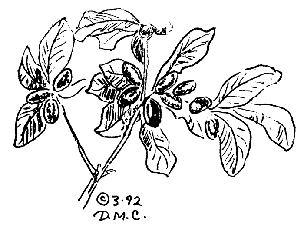
Fig. 1
It
can happen to anyone, all over the world. Once it could happen only to
those who lived, or visited, tropical areas. But if certain people have
their way, the number of unwitting victims will grow yearly by leaps
and bounds. Anyone with an interest in unusual fruiting plants will
become suspect; the temptation for perpetuating the hoax will become
overpowering and even those stalwart folks who would never think of
playing practical jokes upon their visitors will give in to the
temptation.
Let's hear from an habitual perpetrator, in his own
words... "when showing visitors around the property they say, what are
those little red oval berries? Are they edible?' So we give them a
taste and admit they are pretty insignificant. Then when we get to a
lime tree we announce. This is a special Jambolana Lime—very
sweet!' Disbelief is in their eyes, because they've got lime trees in
their gardens, and they can't see any difference—and there isn't!
So we snip off a fat green lime, cut it in half and say. Try it.'
There's a tentative lick, then an incredulous smile, then more licks.
Everyone wants to taste it. 'Wonderful, where did you get it? Did you
grow it from seed? Or was it grafted? Will you let us have some scions?
Will you make a marcotte for us?' Etc., and so the hoax goes on." And
so Jack Rolley of Jambolana Farm in Tahiti boasts of his habitual
duplicity.
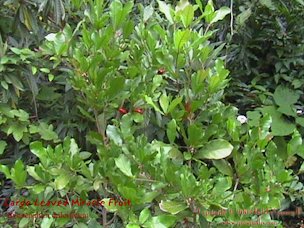
Fig. 2
Large leaved Miracle Fruit
Even
a founder of the Rare Fruit Council, William Whitman, admits to falling
for the sweet lime trick. In 1952, he was being given a tour of the
Panama Canal Zone Summit Gardens by the Director, W. R. Lindsay, when
they encountered a five foot bush, covered with small, dark green
leaves and attractive red fruit about the size of olives. Sampling a
couple of the berries, Mr. Whitman found them rather nondescript, and
they moved to the next specimen, a Key lime which Director Lindsay
asserted was a wonderful and very rare sweet lime. After some urging to
sample it, Mr. Whitman tasted this lime and found it absolutely living
up to its advance billing—incredibly sweet and delicious. Only
after eating several more of these delightful sweet limes did he
finally ask for information. Has this happened to you, or someone you
know? I certainly hope so—because that kind of magical, although
admittedly duplicitous, experience is one not easily forgotten. And it
should make you into an enthusiastic devotee—although NOT of the
"sweet lime", which still, at this writing, dwells amongst unicorns and
other mythical beasts—but of the small red berries that are the
real heroes of this tale.
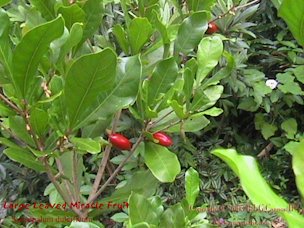
Fig. 3
Large leaved Miracle Fruit
Members
of the Rare Fruit Council should be much more familiar than the general
public with these red berries, which are most commonly called the
Miracle Fruit; and seldom was a common name more correct! No one knows
for sure when the first person made the discovery about the taste
reversing properties... but it was probably many centuries ago. The
plant was discovered in West Africa, where the native diet revolved
around a few basic foods, none of which were remotely sweet. Their
soups and porridges were sour, their crude cornbread sour, their
fermented palm beer and wine extremely sour. Sweeteners were at a
premium. Can you imagine the delight of these people when someone ate a
few red berries and later ate a meal of these foods, to find everything
suddenly sweet and very palatable? One hopes that the connection was
made right away!
This practice was first reported in 1725 by the
French explorer Des Marchais, although he made no recorded attempt to
name the fruit or describe it fully. This West African wonder was not
botanically identified and named until the middle of the 19th century
as Synsepalum dulcificum,
a member of the Sapotaceae family, relative
of the sapodilla (Manilkara
zapota). In the Pharmaceutical Journal,
Vol. Xl, published in 1852, Dr. W. F. Daniell called it the "miraculous
berry". He was stationed at an outpost in West Africa, and described
the taste-reverse properties in great detail. Contemporary botanists
were very naturally excited by his writings and possibilities for
commercial exploitation were eagerly discussed.
A great deal of
time, thought, planning, dreaming, and money have been spent on that
very idea during the last century and a half. Yet the general public is
still unaware of this rare fruit and the effect it could have on
enhancing the quality of their lifestyle.
One of the first
problems encountered was that the berries are perishable, and once
picked, last but a few days. In their native habitat, two large crops
are available yearly, each after a rainy season. The mature bushes,
which can reach 20 feet, usually have a few fruits hanging around all
year. Methods of shipment in the last century were not conducive to
marketing the fruits and cultivation of the plants in other countries
was also unsuccessful. However, a few very rare plants made it around
the globe—such as to Summit Gardens, Plant Introduction Station
in Panama, where one hundred years later, their encounter with one very
dedicated fruit enthusiast has made all the difference for their future
in the diets of people everywhere.
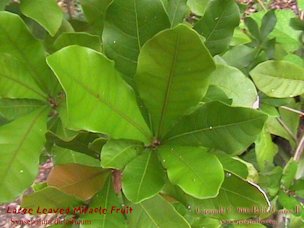
Fig. 5
Leaf habit
Space
does not permit many details in the most extensive—and most
expensive—endeavour to introduce and market the miracle fruit.
Please refer to the magazine, "Horticulture", January 1985, where
author Nathaniel Tripp more fully delves into this mid 1970's
entrepreneurial disaster, involving dedicated dreamers, horticultural
expertise, brilliant marketing ideas, millions of dollars (private,
corporate, and governmental), thorough research, countless hours in
laboratories, greenhouses, fields and offices, industrial espionage,
propaganda and frightener techniques, thousands of miles of air travel,
foot-weary jungle exploration, shrewd native peoples... in short,
everything needed for a Hollywood block buster!
In a nutshell,
although the miracle fruit had been proven to be absolutely and totally
safe in the most thorough testing done on every thing from guinea pigs
to school children, the company set up to market the fruit and its
taste reversing property, Miraculin, was denied crucial FDA approval.
This was quite ironically, on the eve of its major introduction into
the marketplace, and after ongoing communication with the Food and Drug
Administration that had always seemed positive and optimistic.
Consumers
are rarely cognizant of the life-and-death struggle going on in the
food industry; and nowhere is the battle more bloody than when it comes
to sweetening our food. Cane sugar alone is a multi-billion-dollar,
international industry. And when it comes to artificial sweeteners...
we are talking major war! The lovely and graceful branches of Synsepalum dulcificum
are hardly material to fashion weapons of battle. But for a while
there, diabetics, dentists, the overweight, children and all of us who
crave our sweets with no retribution were very close to a major
improvement in lifestyle.
There are no artificial sweeteners proven absolutely safe. (Although
THEY are FDA-approved.) They are used
with
fingers crossed. Sugar and other "natural" sweeteners are hardly to be
considered as food with no ill effects. Hundreds of pounds per person
are consumed yearly in more foods that we can suspect or easily detect.
A teaspoonful in every tablespoonful of ketchup, for example!
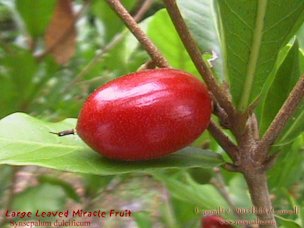
Fig. 6
Fruit
Anyone
with knowledge of diabetes will comprehend the power of sugar in the
diet, with the dangers of this disease to include blindness, stroke,
dizziness, blackouts, coma, painful neuropathy, kidney failure,
amputation and death. Ask a diabetic about the difficulty of
balancing—or detecting— sugar in his diet; an imbalance can
prove to have disastrous results. Ask any little kid in the dentist's
chair about the sugar that caused his cavities. Ask any one of us
"civilized" folks who could stand to lose a few pounds about the
difficulty of resisting the onslaught of advertising designed to make
us eat sugar in some form or the other. Studies have shown human beings
crave and need sugar from earliest infancy. We need it for growth and
energy. But only up to a point—most of us, being human,
overindulge; and thereby pay the price.
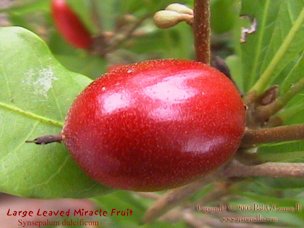
Fig. 7
Fruit close-up
Life
is too short, and too full of woe, to deny ourselves ice cream. (NOTE:
To fully appreciate ice cream, of course, never eat it while depressed
and standing in front of the open freezer. Try to make it to the beach
to eat with a loved one while watching the sun rise or set. This is the
only proper way to eat the very best foods.) There is no perfect
solution to every problem; but surely the miracle fruit grows upon this
planet for a reason: to help us live a sweeter life without suffering
dire consequences.
A Miraculous
Modification
The
oft asked question, is naturally: What causes the miracle? Just as the
desire to take commercial advantage of this berry has caused numerous
hopeful experiments, science has also endeavored to learn the secret.
It took many years, much research and accumulated knowledge and
thorough scientific procedures to finally isolate the principle.
In
the early 1960's, the makers of the seasoning powder Ac'cent the
International Minerals and Chemical Corporation, (doesn't that sound
tasty?) spent a year of concentrated effort trying to isolate the
active ingredient but were basically unsuccessful. It was felt that
larger quantities of the fresh fruit would have expedited their work.
In 1964 their researchers stated, "the quality of the miracle
fruit-induced sweetness is unexcelled... (and) more desirable than any
of the known natural or synthetic sweeteners".
At Florida State
University in Tallahassee, a professor of biophysics. Dr. Lloyd
Beidler, began his studies of miracle fruit in the late 1950's.
Together with Dr. Kenzo Kurihara, he successfully isolated the active
principle, publishing their results in "Science", Vol. 161, September
20, 1968. Research performed independently in the Netherlands under the
sponsorship of the Unilever Company culminated in the same year. It was
found that a glycoprotein causes the taste-modification effect, a
giant, 'macro-molecule' with a molecular weight of 44/000. The size of
this molecule made it difficult, if not impossible, to synthesize it.
This was one of the reasons I. M. C. had determined that the miracle
fruit had no real commercial potential; vast plantations would have
been necessary to supply enough fruit for the large scale production
they envisioned.
Drs. Beidler and Kurihara had access to a
sufficient number of fresh berries, which were grown in a greenhouse at
the university. The miracle fruits were stored in the deep freeze until
needed; 300 at a time were used to make a potent solution through
standard scientific procedures. Through their thorough tests, they
discovered that the taste-modifying activity was destroyed by heat, or
when exposed to organic solvents, and was greatly reduced by exposure
to pH above 12.0 or below 2.5 at room temperature. Situations with a pH
of 3.7 and temperature of 4°C caused the activity to remain
stable for one month.
It was also concluded that the protein was
basic, and contains no other protein within the active component. It
does have bound to it two sugar molecules; the active principle
therefore contains a small amount of sugar—6.7%, which was
determined not to be an impurity. This is what makes the active
principle of S.
dulcificum a glycoprotein. Glycoproteins are known to
be completely innocent of any toxicity and are readily metabolized by
the body.
The active principle does not itself have a sweet
taste, or any noticeable taste. Placing a quantity in the mouth
together with a sour substance initially tastes sour, but will slowly
change to a sweet taste as the protein binds gradually to the receptors
of the taste buds, modifying their function. Eating more than one fruit
does not increase the intensity of the modification.
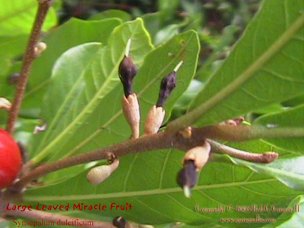
Fig. 8
Miracle fruit flowers and fruit
Miracle
Fruit Flowers
Other
research, by Dr. Linda Bartoshuk on behalf of the U. S. Army, was begun
in 1966 at their laboratories in Natick, Massachusetts. Dr. Bartoshuk's
specialty was the psychology of taste; her interest was in the miracle
fruit's military potential. Since the fruit could make such barely
palatable foods as those consumed in West Africa into culinary
delights, it seemed logical that Army food could also stand similar
improvement. After years of exhaustive research, she read a paper in
1970 at the Army Research Conference in West Point, that was very
positive in its support of miracle fruit. Thorough analysis concluded
that no toxic heavy metals were present. Huge quantities of miracle
fruit concentrate- 3,000 times ordinary human consumption — were
proven to cause absolutely no ill effects. (In fact, the health of
their laboratory animals was improved by miracle fruit consumption!)
Foods such as vegetables, meats and others that were not usually sour,
were not affected, although in some cases the flavor of vegetables did
improve. It was believed that some foods had flavors which were
previously masked, and were beautifully brought out by the miracle
fruit's principle. This effect would last for at least an
hour—some variation seemed to depend upon how long the fruit was
held in the mouth before eating other foods (possibly due to how well
the glycoprotein coated the taste buds). Until saliva eventually
hydrolyzed the glycoprotein, acidic foods would continue to taste sweet
as the sweet receptors continued to "fire" by exposure to sour foods.
This has been known to last 18 hours in rare cases. No aftertaste was
ever reported; although other flavors were slightly enhanced, such as
the degree of saltiness.
It should be noted here that it was
also proven beyond doubt that the central nervous system is not
affected by the miracle fruit, which was a concern of the FDA, which
was also fearful that children could be harmed by the dulling of their
natural taste defenses, allowing them to consume harmful substances.
Small children are most frequently poisoned by aspirin; miraculin was
tested and proven NOT to mask its characteristically bitter taste.
Organic acids- especially citric acid—are the substances that are
modified to the greatest degree. Battery acid will NOT become a tasty
drink.
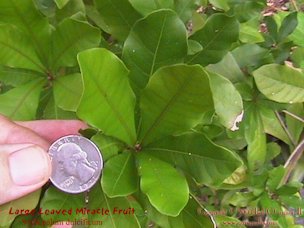
Fig. 9
Large leaved Miracle Fruit
Cultivation:
History and Requirements
David
Fairchild, renowned botanical explorer, who introduced thousands of
important plants to this country, also encountered this phenomenal
fruit while visiting an agricultural experiment station in Cameroon in
1919. He consumed a number of the berries, but admittedly did not pay
attention to the tale of their properties told him by his native guide.
An hour later he was back on his yacht, refreshing himself with a
German beer, which tasted unnaturally sweet. Remembering the story, he
immediately sampled a lemon, to find it as sweet as a honeyed orange.
Naturally, he realized the importance of this plant and gathered all
the seeds he could find. He eventually made four introductions, up
until 1939, into the United States. Unfortunately, none of the plants
survived for very long.
Actually, one of the many virtues of
miracle fruit is its ease of cultivation — although, like any
plant, it politely requests that you learn its likes and it dislikes
before inviting it into your home or garden. Those early failed
attempts to introduce it into the United States were certainly not due
to neglect, as they took place at the U.S.D.A. Plant Introduction
Station, Chapman Field, on Old Cutler Road in Miami. Bill Whitman was
the first to grow it successfully here. The previous specimens had
probably died due to being planted in our alkaline limestone based
soils, according to Dr. Robert J. Knight, Jr., research horticulturist
now at Chapman Field. Whitman's seedlings were sprouted in acidic peat
moss and later planted out in black hammock soil with a pH of 6.4.
These plants seem to live for acid—thriving in it, and then
converting it!
Some plants seem to have more, for lack of a
better word, "personality" than others. Consider—its fruit
enhances your diet with the healthful benefits of sweetness without
calories its beauty adds to your environment and its eagerness to
supply you with its bounty will certainly charm you. The miracle fruit
is unusually well suited for container growth (once you are aware of
its need for acidity). Bill Whitman has seen a seedling all of 7" tall
and a cutting of 4" bearing fruit upon their youthful twigs.
In
Florida, Robert Newcomb's nursery, in 1960, was the first to sell
miracle fruit plants, and seeds for $1.00 each. They were descendants
of Bill Whitman's original Panama discovery. Christopher Whitman had a
nice little cottage industry going as a youngster; his father told me
that he (Bill) would eat 100 berries at a time to clean them, so that
Chris could sell them to Fred Saleet of The Banana Tree in Pennsylvania
at 25 cents each. If ever there lived a person who was an example of
the benefits—and harmlessness—of the miracle fruit, it's
Mr. Whitman, having consumed countless thousands of the berries since
1958 and doing just fine! (William (Bill) F. Whitman, Jr passed away in
his sleep at the age of 92 in 2007. He read and enjoyed this article
and commented that it was the best of any article on miracle fruit that
he had ever seen. - web editor)
Although not thought to be frost
tolerant, they have been observed growing in unprotected locations as
far north as Tampa. It is not a fast growing plant, which is another
benefit for those who would like to grow it in their house or
greenhouse. It thrives under warm temperatures, and high humidity, like
most descendants of rainforest denizens.
There are never any
rules in the natural world that are absolute. There are too many
variables. In the 1970's, for example, during the big push to bring
miracle fruit into the daily diet of Americans, the best individual
plants were sought out and bred for their characteristics—fastest
growth, highest yield, biggest fruit, as horticulturists always seek to
do. What happened to those thousands of well bred S. dulcificums in
those plantations in Jamaica, Puerto Rico and Dahomey is not known by
this writer. Bill Whitman has bred a larger-leaved variety that thrives
in his Bal Harbour grove. Dr. Robert McNaughton has a "giant" miracle
fruit in Coconut Grove garden (refers to the taste of the fruit, not
the tree itself.)
Grow The Dream
It's
just a shrub, with a varying number of small red fruits. And at one
time I was skeptical of its potential, its safety, its practical use in
everyday life. I am now convinced that this is a fruit that is truly a
gift to humanity; not a perfect solution, but a way to improve our
diets and our health with intelligent usage. I was glad to discover
that research is still going on, especially in Japan, where Dr.
Kurihara and his wife are guiding the development of sugar
replacements, using the miracle fruit, among other plants.
This
plant deserves to become much more than a charming oddity in our
gardens, a practical joke to play upon our visitors. It deserves our
respect for its potential to revitalize our dietary habits. It does
takes a bit of re-education to change our wicked, sugary ways and fully
utilize the unique properties of the miracle fruit. Modem day life
demands everything be ultra convenient; using the miracle fruit has
been not as easy as many of us would have wished. One scenario involves
eating a single fruit before the morning grapefruit, a la Bill Whitman;
or to fully enjoy the delights of a bowl of tart strawberries. However,
part of the problem of utilization involves sweetening coffee and soft
drinks. It will make beer taste like lemonade! But lemons taste like
lemon sherbet.
It is unfortunate that heat destroys the active
principle, so that canning, jams, preserves, baking, drying, etc. are
impossible. The fruits can be held for a short period of time by
refrigeration or freezing. There was a powdered concentrate available
briefly in the 1970's, produced by that now-defunct Mirlin-Corporation,
that would've made life a lot sweeter and less fattening for us all
with great convenience. We have the FDA to thank for its absence.
It
is certainly within the realm of possibility that every household could
be graced with at least one miracle fruit plant. A 10 inch plant is
happy in a one gallon pot, in a medium containing peat moss or other
acidic well drained soil mixture. One that size will flower and fruit
at least twice a year, probably more frequently. Eventual size depends
on where the plant is grown; a plant 10 years old might be only 3 feet
tall. Bill Whitman's 20 foot beauty is about 25 years old. He has
harvested 850 fruits at one time. (See TFNews, February 1992, page 2
for a photograph of this beautiful tree.) I have seen 6 foot trees in
pots that were about 10 years old. A lot depends upon the grower!
Water
about every three days—as in every houseplant, DON'T OVER WATER;
feel the soil first. If your indoor humidity is not high enough, create
a mini greenhouse by placing a clear plastic bag, supported by three or
four sticks thrust into the soil, over the entire plant. Do not let
intense sun fall upon the plant when in the mini greenhouse or the poor
thing will cook! The bag can cover the plant for six months with no ill
effects; remove it when the humidity is 50% or higher for extended
periods.
When removing it, do so over two or three days, and
from the bottom up. Whether inside or out, fertilize on a regular
schedule. Some use an azalea type fertilizer; Bill Whitman recommends a
20-20-20 soluble plant food; 1/4 tsp. in a gallon of water, applied
while watering every other week. Suitable brands are Peters, Hyponex or
Hy-Gro.
Sources of miracle fruit plants or seeds? A number of your fellow RFCI
members grow Synsepalum
dulcificum,
and make seeds available regularly through the Seed Bank or at the
monthly meetings. Pat Hartmann, known as the Blueberry King of
Michigan, will eventually be offering thousands of miracle fruit plants
for sale; Bill Whitman has "been sending him seeds for years". Write
for a free catalog to Hartmann's Plantation, P.O. Box E, Grand
Junction, Michigan 49056 (904) 468-2087/468-2081.
Before going
out to the garden to check on my own little miraculous berry, I must
effusively thank Mr. William Whitman for his time, knowledge, advice
and generosity in supplying various otherwise unobtainable literature
that made this article possible. And now off to see how close I am to
being able to play the old sweet lime trick on visitors to my house!
Photographic note: The photos were taken at Crowley's nursery,
Sarasota, Florida. There are two variants of Synsepalum dulcificum,
one has larger leaves than the other. These photos are of the larger
leafed variety. Bill Whitman also grows a species that has leaves about
8 inches long but it has never set fruit in Florida and is reputed not
to contain the taste changing glycoprotein. The editors attempts to
propagate this plant by cuttings and marcotting have been unsuccessful.
References
Beidler, L., and Kurihara, K. "Taste-Modifying
Protein from Miracle Fruit", Science, Vol. 161, September 1968.
Cagan, R.H. "Chemostimulatory Protein: A New
Type of Taste Stimulus," Science, Vol. 181, July 1973.
Facciola, S. Cornucopia, A Source Book for
Edible Plants. Vista, California: Kampong Publications, 1990.
Fairchild, David. Garden Islands of the Great
East. NewYork: Charles Scribner's Sons, 1943.
Hoyos Femandez, J. Frutales en Venezuela.
Caracas, Venezuela: Sociedad de Ciencias Naturias La Salle, 1989.
Martin,
F. W., Campbell C. W., Ruberte, R. M. Perennial Edible Fruits of the
Tropics An Inventory. U.S. Department of Agriculture, Agriculture
Handbook No. 642.1987.
Tripp, N. 'The Miracle Berry"; Horticulture,
January 1985.
Van Atta, Marian. Growing and Using Exotic
Foods. Sarasota, Florida: Pineapple Press, 1991.
Wallace, J. F and M. J. Miracle Fruit: How
Sweet It Is. Colville, Washington: Jenwa Enterprises, 1981.
The Merck Index, An Encyclopedia of Chemicals,
Drugs and Biologicals. Entry #6072, Miraculin. 10th Edition, 1983.
Whitman, W. F. "How to Grow Your Miracle Fruit".
Whitman, W. F. "Miracle Fruit". Miami, Florida:
The Rare Fruit Council International.
Back
to
Miracle Fruit Page
|







